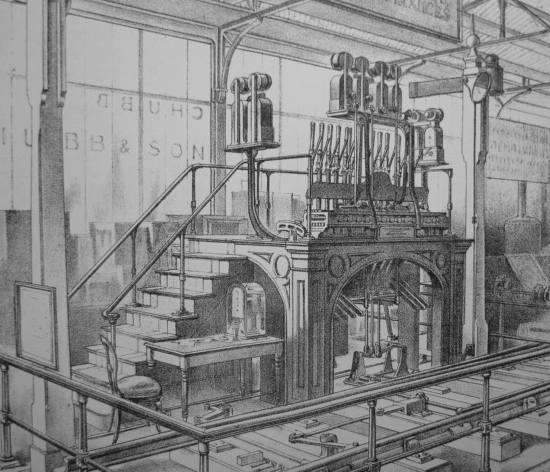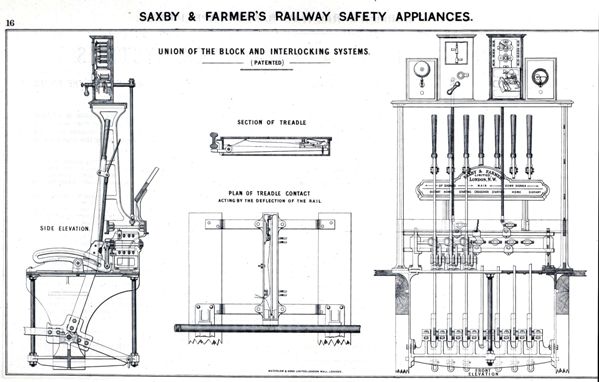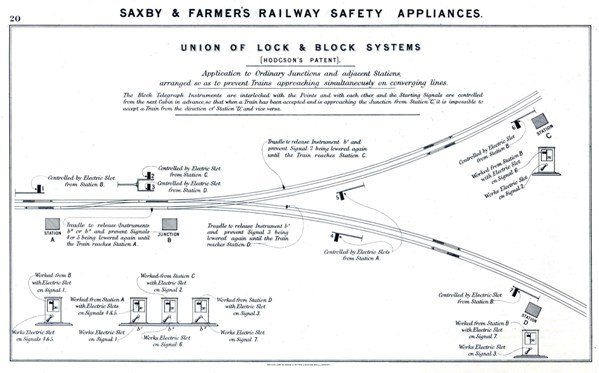UNITED LOCK AND BLOCK WORKING

Illustration of full size Working Apparatus. Gold Medals Paris Universal
Exhibition 1878, and Barcelona 1888
This Apparatus is now on view at the works at Kilburn, and the efficient
working of it may be tested practically.
UNION OF THE LOCK AND BLOCK SYSTEMS
EXCERPT -- GENERALl REPORT TO THE BOARD OF TRADE UPON THE ACCIDENTS WHICH
OCCURRED ON THE RAILWAYS OF THE UNITED KINGDOM DURING THE YEAR 1881
PRESENTED TO BOTH HOUSES OF PARLIAMENT. Pages 34 and 35.
The inquiries into the accidents of the past year speak very conclusively
in favour of an early completion of the Absolute Block System of working
on all Passenger Railways, and that that system should be supplemented by
some means for preventing mistakes of Signalmen, which so often occur, and
which in the present and previous years have led to very disastrous collisions,
as at Canonbury. In this matter a report has been received from the Chief
Inspector of his inspection, at the request of the London Brighton and South
Coast Railway Company, of a means of accomplishing this object which has
been put down as an experiment on a part of their railway. Colonel Yolland
reports as follows:—
Sir,
24th- August, 1881.
" I have the honour to report, for the Information
of the Board of Trade, that, in compliance with the instructions contained
in your minute of the 9th instant, I have inspected the union of the
Lock and Block system (Hodgson's patent) which has been laid down by the London
Brighton and South Coast Railway Company on a portion of their new Tunbridge
Wells and Eastbourne Line, viz., at Heathfield, Horeham, Hellingly and Hailsham
Stations. There are loop lines or passing places at all these stations except
at Hellingly, where there is no loop line, but the new line, except
at the stations indicated, is a single line of railway.
One of the principal alterations introduced
by Messrs. Saxby and Farmer in the recent Improvements of the Lock and Block
apparatus has been the introduction of a treadle near each signal box,
electrically connected with the telegraph instruments in the signal boxes
at the stations, rendering it necessary in the working of the Block system
that the actual running of each train should exercise a most important control
over the signalmen in the signal Boxes. Thus, on the wheels of an arriving
train passing over the treadle, whioh may be placed in advance of or some
distance beyond the signal box, permission is thus given to the signalman
in that box that he may give back ' Line clear' by the telegraph instrument
to the station from which the train has arrived, and thus telling the signalman
there that the line between the two signal boxes Is clear of the train whioh
he had last despatched, and was ready for another train to proceed.
You are aware that the idea of making a train
contribute to the safety of the public travelling on railways by telegraphing
its own arrival at stated points, is by no means new, and has long been
advocated by the inspecting officers of the Board of Trade, and sundry experiments
have been made to carry it into effect with success, but this has hitherto,
as ar as I am aware, been found impracticable from the liability of the treadles
to get out of order or to be destroyed altogether by the repeated blows reoeived
from the wheels of a train in rapid motion. This objection has now, I think,
been satisfactorily got rid of in this system, by making the deflection of
the rail Itself, acting upon the short arm of a lever always in contact with
the underside of the rail, the means of making an eleotrical contact through
the long arm of the same lever with the telegraph instruments in the signal
boxes. This electrical connexion with the telegraph instruments in the signal
box takes off a look that prevents the signalman from moving the handles
by whioh the signal 'Line clear' is transmitted.
This part of the apparatus is only likely
to fail from the power of the battery not being properly maintained, or from
carelessness on the part of the platelayers in disturbing the treadle which
is placed between the rails in the four-foot space, and if out of order, must
at once become apparent to the signalman in the adjacent signal box.
Another important alteration consists in the
introduction of the ' electric slot,' by which the starting signals at one
station are controlled from the next station in advance, so that | it is
rendered impossible for the signalman at a station to lower the out-of-door
'starting signal' for a train to leave that station until he has received
' Line clear' from the next station or signal box in advance; and as
soon as a train has been started and signalled to the station or signal box
in advance, and is acknowledged by the signalman in advance sending back 'Line
blocke' on the telegraph instrument,' the starting signal' is simultaneously,
and by the same act of sending 'Line blocked,' again put to 'danger.'
This is not optional, but compulsory. as the very act of pressing in the plunger
puts the starting signal at the rear station to 'danger.'
The arrangments by which, hitherto,
a single signalman might at any time make a mistake, and give back 'Line clear'
when it is not clear, or send on a train through a mistake in signalling when
it should not have been sent on, are altogether changed. The
assent of two men is by this system required to make a mistake, and this
is coupled with the further security obtained from the train itself virtually
telegraphing its own arrival
at the advanced station or signal box, so that I do not see how, if this system
be adopted and is faithfully carried out, a collision between folloving trains
can take place.

UNION OF THE BLOCK AND INTERLOCKING SYSTEMS.
Attention is invited to this invention for uniting the working of the Block
and Interlocking systems -- making them absolutely INTERDEPENDANT, and obviating
the possible danger hitherto existing of contradiction between the BLOCK TELEGRAPH
INDICATIONS transmitted from one station to another, and the Out-door Signals
exhibited to Engine Drivers.
The invention carries the security of the Interlocking of Point and Out-Door
Signal Levers a step further, it combines in one and the same apparatus those
Levers, and also the Handles of the Train Telegraph Instruments. The Levers
and the handles being interlocked reciprocally, with the result that there
cannot be any contradictory working between the Out-door Signals and Points,
NOR BETWEEN THE OUT-DOOR SIGNALS AND POINTS, AND THE TRAIN TELEGRAPH
SIGNALS TRANSMITTED ELECTRICALLY.
When it is considered that after all, whether in respect of the Block System
or the Interlocking System, or both, it is upon the correct working of the
Out-door Signals, and their due observance by the engine drivers, that the
whole safety of Railway traffic depends, it would be difficult to over-estimate
the importance of the object of securing as absolutely as possible the correct
working of the Out-door Signals.
The illustration ----- shews a machine in which is contained an Interlocking
Apparatus of 7 Levers for working Points and Signals, and 2 Improved Block
Telegraph Instruments, for the exchange of Train Telegraph Signals with the
Stations on either side, for Up and Down lines respectively. The Handles of
the Block Instruments and the Point and Signal. levers being combined in
one and the same Interlocking Mechanism, they cannot be manipulated in a
contradictory manner.
The Block telegraph Instruments shewn in the drawing are of improved construction,
simple, efficient and strong, one line wire only is required for the Signals
for both Up and Down lines, and for the bells in both directions. The Locking
Handles are attached to hollow spindles, in the centre of which are the spring
commutator plungers.
When the Handles are moved to the right (which is the position of "Line
Clear ") they work interlocking gear so as to Interlock the Point and Signal
Levers in any pre-arranged manner as may be necessary to suit traffic requirements.
When the Handles are moved back to the 'Line Blocked' position, they are stopped
in mid-stroke and become firmly locked, so that they cannot be moved again
to the right for the purpose of giving 'Line Clear' for a second Train,
neither can they be placed in their normal position so as to unlock the Point
and Signal Levers until the approaching Train has arrived and passed over
the Treadle Apparatus shewn in the illustration.
On passing over the treadle the weight of the train deflects the rail and
presses down the short end of a lever which is pivotted in a cast-iron box
fixed to the sleepers; as this short end descends the long end rises and completes
the electrical circuit, so that a current of electricity is sent through
the Magnet of the Block Instrument, Unlocking the Handle which can then either)
he restored to its normal position to unlock the Point and Signal Levers,
or it can be again moved to the right to give 'Line Clear' for another Train.
See also Improved Rail Contact Maker, page 33.
The arrangement of this Treadle
and its action will be readily understood from the
illustration. It will be seen that it satisfactorily gets rid of the
difficulty usually experienced with Treadles acted upon by passing trains,
viz::- their liability to get out of order or be destroyed by the violent
blows received from the wheels of Trains in rapid motion. The short
ends of the Treadle Lever being always in contact with the underside
of the rail, the wear and tear is reduced to a minimum, and consequent upon
the relative proportions of the short and long end of the Lever, a very
slight deflection of the Rail gives quite sufficient movement for insuring
satisfactory electrical contact.
The improved instrument may be used in connection
with any type of Leverlocking Apparatus,
and may be used the Treadle as above described or not. When the
Out-door Semaphore Signals are controlled by the Electric Slot Apparatus,
shewn and described, page 18, 36 & 37, the plungers of the Block Instruments,
on being pressed in, act upon the ELECTRIC SLOT APPARATUS as well as upon
the Miniature Semaphore Arms of the Block Instrument at the next station,
and the combination thus effected constitutes the Simplest and Most Perfect
Block System in Existence.
APPLICATION TO SINGE LINES
The Starting Signals being controlled from the next Station in advance a
signal for a train to proceed can not be given until 'Line Clear' has been
received on the telegraph instrument; as seen as a train enters a section
the signal is put to 'danger' and cannot be again lowered unitl the train
has come out of the section at the other end, when it passes over a Tradle,
which releases the instrument there, neither can the signal for the opposite
direction be lowered whilst a train is in the section.
APPLICATION TO ORDINARY JUNCTIONS AND ADJACENT
STATIONS

Saxby & Farmer page
Interlocking
Startsidan Home Page
Sidan uppdaterad den 18 augusti 2013
